By KONSTANTIN TOROPIN, Associated Press
WASHINGTON (AP) — Since sending the National Guard to Los Angeles and Washington, President Donald Trump has openly mused about sending troops to some of the nation’s most Democratic cities — including Chicago and Baltimore — claiming they are needed to crack down on crime.
Related Articles
Chicago is in the Trump administration’s sights for its next immigration crackdown
Want to work for National Weather Service? Be ready to explain how you agree with Trump
Sen. Ernst of Iowa is expected to announce next month that she won’t run for reelection in 2026
Appeals court blocks Trump administration from ending legal protections for 600,000 Venezuelans
Texas governor signs new voting maps pushed by Trump to gain five GOP seats in Congress in 2026
The threats to expand a federal intervention have legal experts and some military officials raising concerns that Trump is considering novel ways to use National Guard troops in American cities that could set up conflicts not seen since the civil rights era.
Though most violent crime has fallen in recent years in the cities Trump has called out, the Republican president said Democratic Illinois Gov. JB Pritzker “should be calling me, and he should be saying, ‘Can you send over the troops please?’ It’s out of control.”
Whether Trump can repeat what he’s done in LA and the nation’s capital — call up the National Guard and have it assist a surge of federal law enforcement and immigration officers — is an open question and likely to become a point of contention should he press forward.
Here’s a look at how Trump has used troops in U.S. cities, what the law allows and what could come next:
How Trump already has used the National Guard
Trump first deployed troops to Los Angeles in early June over Gov. Gavin Newsom’s objections by putting the California National Guard under federal jurisdiction, known as Title 10, to protect federal property from protests over immigration raids.
Besides 4,000 Guard members, Trump later sent 700 active duty Marines, and California sued over the intervention. The Guard went on to help protect officers during immigration arrests.
While Trump pushed the limits of the law, the lawsuit centers on whether the president was allowed to use the Guard to closely shadow federal law enforcement and whether that runs afoul of the prohibition on using the military as law enforcement, known as the Posse Comitatus Act, said Todd Huntley, director of the National Security Law Program at the Georgetown University Law Center.
Meanwhile, the unique status of the District of Columbia National Guard — Trump is their commander in chief — means he has been able to use it for everything from armed patrols to trash cleanup without any legal issues. Because it is on state and not federal orders, legal restrictions on law enforcement don’t come into effect.
“Where we have a big question mark” is whether “the governor of a state has to consent to the sending of troops to his state,” said Huntley, a retired Navy captain and judge advocate.
How this could play out in Chicago and other cities
The Trump administration is planning to surge officers to the nation’s third-largest city for an immigration crackdown, two U.S. officials said.
The Department of Homeland Security asked Naval Station Great Lakes outside Chicago for support on immigration operations, including with facilities and logistics, the base said this week. The Illinois National Guard and the base said they had not received requests regarding a mobilization of troops to Chicago.
If Trump wants the freedom to use the National Guard as he pleases in Chicago, the easiest legal path is to invoke the Insurrection Act — a vaguely worded 1792 law that allows the president to deploy federal troops inside the U.S. to conduct law enforcement, an exception to the restrictions of the Posse Comitatus Act.
The law offers sweeping powers to the president, envisioning armed conflict within the United States.
“The orders would be given by him … and the governor of the receiving state would not have a say in whether he allows them into the state or not or allows them to conduct a mission in the state,” Huntley said.
However, Huntley calls this “the nuclear option.”
A D.C. National Guard official, who spoke on condition of anonymity for fear of retaliation, said invoking the Insurrection Act over a broad topic like crime could allow the Guard to be deployed indefinitely.
Another possibility is Trump deploying the D.C. Guard, which he commands, to another state, the official said.
If the D.C. Guard is put on federal orders — something Trump has the power to do — it could lead to some rare situations, including federalized D.C. Guardsmen sent to another state that in turn could activate its own Guard as a counter, Huntley said.
The possibility is not without precedent.
“The resolution of that could be basically what we saw in Alabama during the civil rights era. To take the ability of that state governor of using state National Guard forces away, the president could simply federalize them,” Huntley said.
In 1963, President John F. Kennedy federalized the Alabama National Guard as part of the now-famous standoff with Gov. George Wallace, who refused to step aside and allow Black students to integrate the University of Alabama. Wallace eventually relented.
Members of the Louisiana National Guard patrol Union Station, Thursday, Aug. 28, 2025, in Washington. (AP Photo/Mariam Zuhaib)
How Trump’s new executive order on the National Guard affects what happens next
In an executive order signed Monday, Trump ordered Defense Secretary Pete Hegseth to create “a specialized unit” within the D.C. Guard “dedicated to ensuring public safety and order.”
He also directed Hegseth to ensure every state’s Guard is ready to assist federal and local law enforcement in “quelling civil disturbances and ensuring the public safety and order” when needed. It also calls for each to have units “reasonably available for rapid mobilization.”
The Pentagon has not given more details of what Trump’s order will mean for the National Guard. A defense official confirmed that Hegseth’s office was aware of the order and that they were reviewing it and its specific requirements.
All state Guards already have a “reaction force” that is aimed at responding to a wide variety of incidents with an initial force of 75-125 personnel within eight hours and a follow-on force of up to 375 personnel within 24 hours, according to a National Guard fact sheet.
And the D.C. National Guard already has a unit that is made up entirely of soldiers trained as military police.



